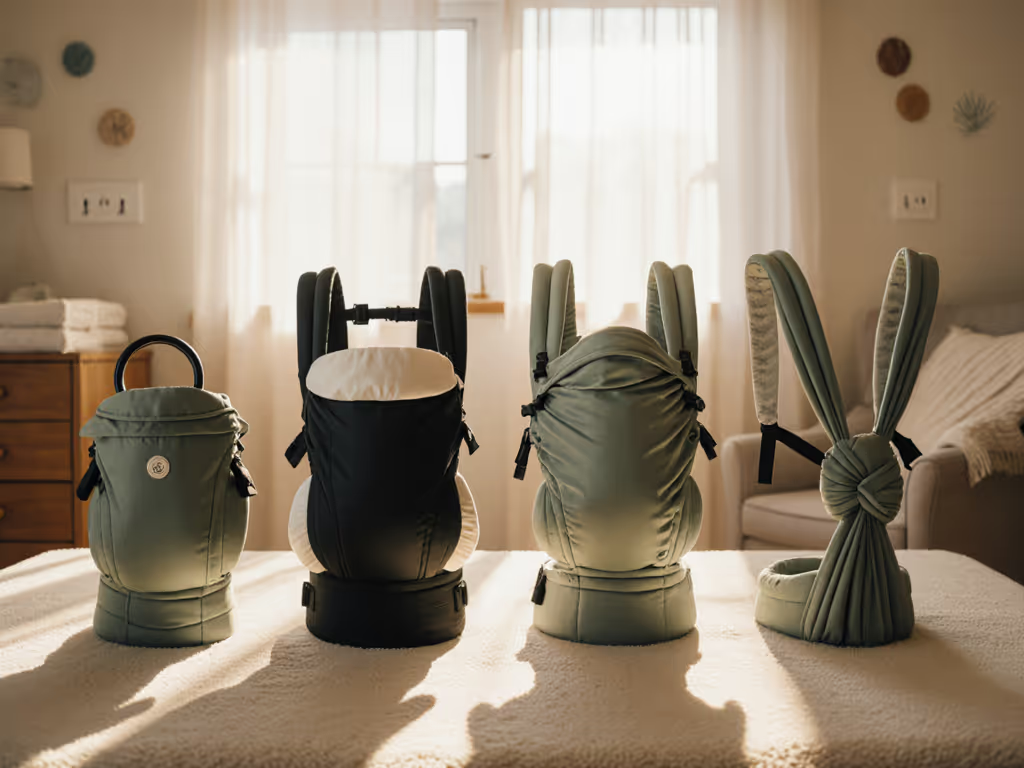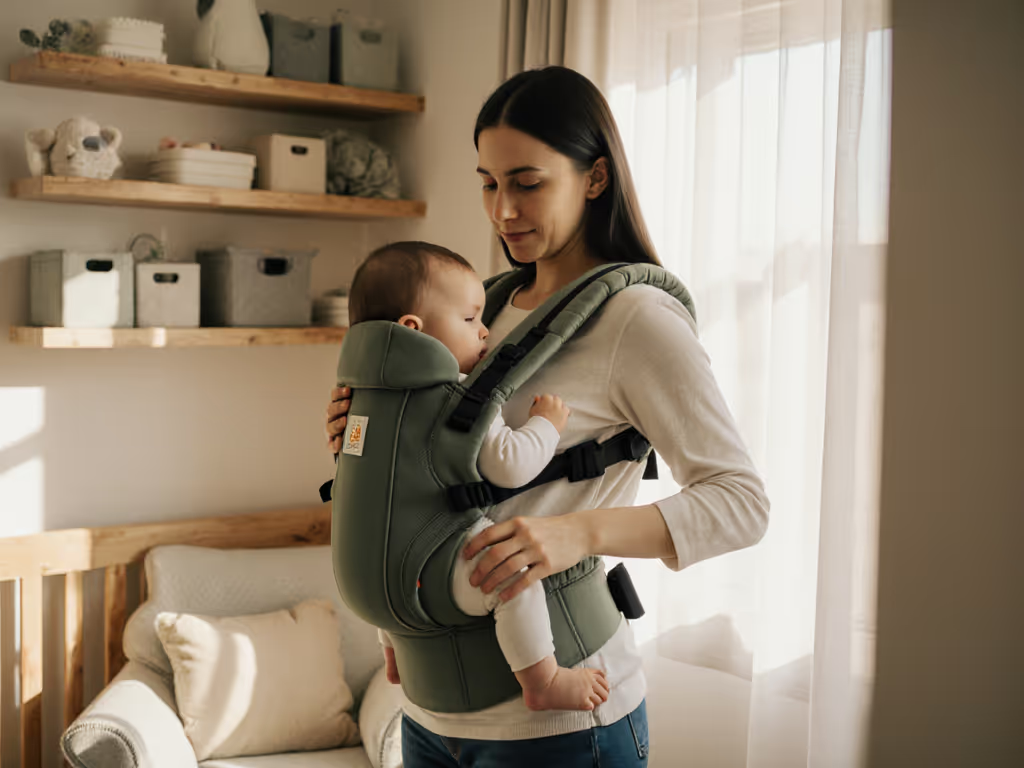
7 Essential Babywearing Positioning Tips for Caregivers

Did you know that improper babywearing can increase the risk of breathing and developmental issues for infants? New parents often focus on convenience or style, but safety and comfort must always come first. Mastering the basics of secure positioning and ergonomic support means you protect your baby’s airways, hips, and fragile neck muscles while creating a close bond every time you wear them.
Quick Summary
| Takeaway | Explanation |
|---|---|
| 1. Keep baby's chin off chest | Maintain at least two finger widths to ensure baby's airway remains open and unobstructed. |
| 2. Position baby 'visible and kissable' | Baby should be at collarbone level for easy visibility and connection while allowing you to monitor their condition. |
| 3. Achieve an 'M' shape for hips | Ensure baby's thighs are spread, knees higher than their bottom to support healthy hip development. |
| 4. Provide consistent head and neck support | Newborns need head support to prevent strain; adjust carriers properly to maintain stability. |
| 5. Regularly recheck carrier fit | Assess and adjust the carrier fit monthly to accommodate your baby's growth and changing body dynamics. |
1. Ensure Baby's Chin Is Off the Chest
Babywearing looks adorable, but proper positioning is critical for your infant's safety. The most important rule? Keeping your baby's chin completely off their chest to prevent potential breathing challenges.
Breathing risks emerge when a baby's chin is pressed down, creating what experts call an airway compression zone. This positioning can restrict oxygen flow and potentially lead to dangerous respiratory complications. According to safety guidelines from leading infant care researchers, you should always maintain at least two finger widths of space between your baby's chin and chest.
To check the correct positioning, perform a simple "chin check" every time you wear your baby. Gently tilt your baby's head slightly up so their airway remains open and unobstructed. Look for these key indicators of safe positioning:
- Your baby's head is slightly tilted back
- There's visible space under the chin
- Breathing sounds are clear and unimpeded
- Baby's face remains completely visible
"A baby's neck muscles are still developing, so caregivers must actively monitor head and neck positioning." - Infant Safety Research Institute
Practically speaking, different carrier types require slightly different techniques. Soft structured carriers, wrap carriers, and ring slings all demand careful attention to maintain that critical chin clearance. When in doubt, practice positioning with a mirror or ask an experienced babywearing consultant to review your technique. Your vigilance can quite literally protect your baby's breathing and overall safety.
Remember: proper positioning is not just a recommendation. It is an absolute necessity for safe and comfortable babywearing.
2. Maintain Visible and Kissable Position
Babywearing is more than just transportation. It is an intimate dance of safety, connection, and caregiving that requires strategic positioning. The "visible and kissable" rule transforms how you carry your little one.
When we say "visible and kissable," we mean positioning your baby high enough on your chest that you can easily see their face and lean down to kiss their forehead. This seemingly simple guideline packs powerful safety and emotional benefits. Keeping your baby in clear view allows you to monitor their breathing, temperature, and overall comfort while creating an instant connection point.
Practically speaking, this means your baby should be positioned near your heart level approximately at your collarbone. Their face should remain uncovered and completely visible from your perspective. Watch for these key positioning indicators:
- Baby's face is fully exposed and unobstructed
- You can make eye contact without moving
- Enough vertical space exists to tilt your head and kiss their forehead
- Carrier fabric does not cover the baby's nose or mouth
"Proximity creates protection. When your baby is close enough to kiss, you create a natural monitoring system." - Infant Attachment Research Group
Different carrier types will require slight adjustments. Wraps, ring slings, and soft structured carriers all have unique positioning techniques. The universal principle remains the same: keep your baby close, visible, and within kissing range. This positioning not only ensures safety but also supports crucial early bonding experiences.
Remember that babies communicate through subtle cues. By keeping them in this "visible and kissable" zone, you become attuned to their smallest signals and needs.
3. Support Baby's Hips in the 'M' Shape
Your baby's hip development is a delicate journey of growth and stability. The "M" shape positioning isn't just a cute pose it is a critical strategy for supporting healthy musculoskeletal development.
Proper hip positioning means creating a natural seated squat where your baby's thighs are spread wide and knees remain higher than their bottom. This ergonomic "M" or "frog" position mimics how babies naturally sit when not in carriers. By supporting this alignment, you protect their developing hip joints and spine from unnecessary stress.
Important elements of achieving the perfect "M" shape include:
- Spreading baby's legs wide around your torso
- Ensuring knees are positioned higher than their bottom
- Allowing natural hip flexion without forcing legs together
- Maintaining a deep seated position within the carrier
"Correct hip positioning during the first months of life can significantly impact long term joint health." - International Hip Dysplasia Institute
Different carrier types require slightly different techniques to achieve this position. Soft structured carriers often have built in seat width to naturally create the "M" shape. Wraps and ring slings demand more intentional positioning from the caregiver. When selecting a carrier, look for designs specifically endorsed by pediatric orthopedic experts.
Practically speaking, test the positioning by checking if your baby looks comfortable and can move their legs slightly. Their weight should be distributed across their entire bottom rather than hanging by their crotch. A well positioned baby will look relaxed and supported.
Remember: good hip positioning now creates a foundation for healthy movement and development later.
4. Secure Head and Neck, Especially for Newborns
Newborns are delicate explorers with neck muscles still developing their strength. Proper head and neck support transforms babywearing from a simple transportation method to a safe bonding experience.
Newborn neck muscles are incredibly weak, requiring caregivers to provide consistent external support. Their heads represent approximately 25% of their body weight and cannot independently maintain position. This means every carrier interaction demands intentional positioning to prevent potential strain or accidental movement.
Key strategies for securing your newborn's head and neck include:
- Position carrier fabric up to the nape of the neck
- Ensure head remains centered and supported
- Check that baby's face remains visible and unobstructed
- Adjust carrier to minimize head wobbling
"A newborn's neck requires continuous support until muscle strength develops around 4 months." - Pediatric Movement Development Institute
Different carrier types demand unique approaches. Stretchy wraps often provide excellent head support through multiple fabric layers. Soft structured carriers require careful adjustment of straps and positioning. Ring slings need strategic folding to create a supportive neck cradle.
Practical tip: Before walking around, perform a gentle "stability check." Hold your baby still and observe their head position. If their head moves independently or seems unsupported, readjust your carrier. Your vigilance protects their developing musculoskeletal system.
Remember that each baby develops differently. What works perfectly one week might need adjustment the next. Stay attentive and responsive to your little one's changing physical capabilities.
5. Check Even Weight Distribution for Comfort
Babywearing looks magical from the outside, but the real art lies in creating a balanced connection that feels comfortable for both you and your baby. Weight distribution is the secret ingredient that transforms carrier time from a potential strain to a seamless experience.
Think of babywearing as a full body partnership. An uneven carrier placement can create unexpected pressure points on your shoulders, back, and hips. The goal is to spread your baby's weight across your core, allowing your strongest muscle groups to support the load naturally.
Critical elements of achieving perfect weight distribution include:
- Positioning baby high and centered on your chest
- Ensuring carrier straps sit evenly on both shoulders
- Utilizing your core muscles for support
- Adjusting carrier height to minimize lower back strain
- Checking that weight feels balanced side to side
"Proper weight distribution prevents caregiver fatigue and supports healthy infant positioning." - Ergonomic Babywearing Institute
Different body types require personalized adjustments. Taller individuals might need longer carrier straps. Individuals with broader shoulders will want wider support panels. The key is experimenting and finding your unique comfortable configuration.
Practical tip: Before heading out, do a quick "weight test." Stand still and assess how the carrier feels. Can you move your arms freely? Does one side feel heavier? Make small adjustments until everything feels balanced and natural.
Remember that carrier comfort evolves. What works perfectly today might need recalibration as your baby grows and your body changes. Stay attentive and responsive to your physical signals.
6. Keep Baby's Face Uncovered for Easy Breathing
Breathing seems automatic for adults, but for infants, every breath requires careful monitoring. Keeping your baby's face completely uncovered is not just a recommendation it is a critical safety imperative.
Infant respiratory systems are delicate and highly sensitive. Even small obstructions like fabric or clothing can quickly compromise their ability to breathe effectively. Newborns and young infants cannot independently move fabric away from their face, making caregiver vigilance absolutely essential.
Key strategies for maintaining an unobstructed airway include:
- Position carrier fabric below baby's chin
- Ensure no material blocks nose or mouth
- Regularly check baby's face for clear visibility
- Use lightweight breathable carrier materials
- Avoid bulky layers near baby's face
"An unobstructed airway is the most fundamental safety requirement in infant carrying." - Pediatric Respiratory Safety Institute
Different carriers present unique challenges. Stretchy wraps can sometimes shift and create fabric folds near the face. Ring slings require careful initial positioning. Soft structured carriers often have design features that help maintain facial clearance.
Practical tip: Before walking around, do a "breathing check." Gently place your hand near your baby's face to confirm easy airflow. Watch for natural chest and stomach movement. If anything seems restricted, immediately readjust your carrier.
Remember that environmental factors like temperature and humidity can impact breathing comfort. Stay attentive and responsive to your baby's respiratory signals.
7. Regularly Recheck Carrier Fit as Baby Grows
Babies transform at lightning speed, and your carrier needs to keep pace with their remarkable growth. Carrier fit is not a one time setup but an ongoing process of adjustment and attentiveness.
Every week brings new developmental milestones that impact how your baby fits in a carrier. Their increasing muscle strength, changing body proportions, and expanding movement range demand consistent reevaluation. What worked perfectly last month might require significant readjustment now.
Key elements to monitor during carrier fit checks include:
- Shoulder strap positioning
- Waistband snugness
- Baby's leg spread width
- Overall weight distribution
- Fabric tension and support
"A carrier that fits perfectly at two months will need recalibration by four months." - Infant Ergonomics Research Center
Different carrier types have unique adjustment mechanisms. Soft structured carriers often feature multiple buckle settings. Wraps require complete retying. Ring slings need sliding adjustments. Understanding your specific carrier's adaptability is crucial.
Practical tip: Perform a monthly carrier fit assessment. Take a moment to watch how your baby sits, check strap positioning, and test overall comfort. Pay attention to your own body signals too. Discomfort can indicate a need for adjustment.
Remember that multiple caregivers might use the same carrier. Always readjust when switching between users to ensure optimal safety and comfort for both baby and wearer.
Below is a comprehensive table summarizing the key babywearing safety guidelines discussed in the article.
| Topic | Key Points & Actions | Benefits/Outcomes |
|---|---|---|
| Baby's Chin Position | Ensure at least two finger widths between chin and chest; perform regular "chin checks." | Maintains open airway, preventing breathing issues. |
| Visible and Kissable | Position baby high on chest, face unobstructed, easy to kiss forehead. | Enhances monitoring and bonding, ensures safety and emotional connection. |
| Hip Support "M" Shape | Ensure thighs are wide, knees higher than bottom; natural sitting position. | Supports healthy hip development and reduces joint stress. |
| Head and Neck Support | Position fabric up to neck; adjust to prevent wobbling. | Ensures safety and supports developing neck muscles. |
| Weight Distribution | Center baby on chest; balance straps; use core muscles. | Prevents caregiver fatigue, distributes baby's weight evenly. |
| Unobstructed Face | Keep carrier fabric below chin; ensure no material blocks nose or mouth. | Ensures easy breathing and maintains unobstructed airway. |
| Regular Carrier Fit Checks | Adjust straps and fit as baby grows; reassess comfort monthly. | Ensures continuous safety and comfort for the baby's changing needs. |
Discover a Safer, Smarter Babywearing Journey
Are you ready to move beyond guesswork and uncertainty in your babywearing routine? This article highlights essential strategies like keeping your baby's chin clear, ensuring ergonomic hip positioning, and regularly checking carrier fit. These specifics matter because a single misstep can put your child's safety and comfort at risk. Many caregivers struggle with questions like, Is my baby's airway really supported? or How can I tell if my carrier is still a good fit as my newborn grows? Your desire to feel confident, relaxed, and connected while babywearing starts with the right resources.
You do not have to figure this out alone. Caregiver Carry is dedicated to simplifying safe positioning and carrier selection for every caregiver. Discover detailed guides on proper babywearing techniques, explore real-world reviews to find the best carrier for your body type, and access safety checklists that match your exact needs. Empower yourself with reliable, evidence-based information so your next babywearing moment is always safe, comfortable, and happy. Take the first step and visit Caregiver Carry now to unlock peace of mind and expert support.
Frequently Asked Questions
How can I ensure my baby's chin is off their chest while babywearing?
To keep your baby's chin off their chest, position them so there's at least two finger widths of space between the chin and chest. Perform a quick "chin check" by gently tilting your baby's head slightly up to confirm unobstructed breathing.
What does 'visible and kissable' mean in babywearing?
The 'visible and kissable' position refers to carrying your baby high on your chest at collarbone level, allowing you to easily see their face and lean down to kiss their forehead. Adjust your carrier so their face remains uncovered for monitoring and bonding.
How do I achieve the 'M' shape for my baby's hips in the carrier?
Ensure your baby’s legs are spread wide and knees are positioned higher than their bottom to create the 'M' shape, which supports healthy hip development. Spread their legs around your torso and maintain a deep seated position within the carrier to achieve this alignment.
What should I do to provide head and neck support for my newborn?
For head and neck support, position the carrier fabric up to your newborn's nape and ensure their head is centered and supported while remaining visible. Regularly check your newborn's head position, especially during walks, to prevent any support issues.
How can I check if my baby's weight is evenly distributed in the carrier?
To assess weight distribution, position your baby high and centered on your chest while ensuring the carrier straps sit evenly on both shoulders. Perform a quick “weight test” by standing still and observing if either side feels heavier or if your arms can move freely.
What adjustments should I make as my baby grows in the carrier?
Regularly assess your carrier fit as your baby grows by checking shoulder strap positioning, waist belt snugness, and baby’s leg spread. Schedule a monthly fit assessment to ensure comfortable and secure positioning as your baby’s body changes.



